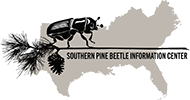Abstract
The southern pine beetle, Dendroctonus frontalis Zimmermann (Coleoptera: Curculionidae: Scolytinae), is among the most destructive bark beetle pests of pines (Pinaceae) of the southeast and mid-Atlantic United States of America, Mexico, and Central America. Numerous volatile compounds can stimulate or reduce attraction of the beetle, but efforts to incorporate these into effective, practical technologies for pest management have yielded mixed results. Attractants have been incorporated into lures used in monitoring traps that are employed operationally to forecast outbreaks and detect emerging populations. The attraction inhibitor, verbenone, shows efficacy for suppressing southern pine beetle infestations but has not yet been adopted operationally. No effective semiochemical tree protectant has been developed for the beetle. We discuss complexities in the chemical ecology of the beetle that likely have impeded research and development of semiochemical management tools, and we describe basic science gaps that may hinder further progress if not addressed. We also report some supporting, original experimental data indicating (1) that a verbenone device can inhibit the beetle’s response to sources of attractant in a radius of at least several metres, (2) similar olfactory responses by the beetle to both enantiomers of verbenone, and (3) that pheromone background can cause conflicting results in semiochemical field tests.
To read the full article please visit the link below:
Sullivan, Brian T., and Stephen R. Clarke. 2021. “Semiochemicals for Management of the Southern Pine Beetle (Coleoptera: Curculionidae: Scolytinae): Successes, Failures, and Obstacles to Progress.” Canadian Entomologist 153 (1): 36–61. https://doi.org/10.4039/tce.2020.67.
